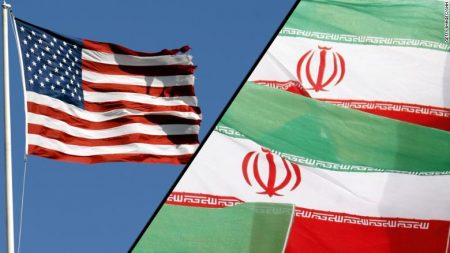Iran quadrupled its Uranium-enrichment production capacity 21/05/2019 – Posted in: Daily News – Tags: enriched uranium, Iran, iran nuclear deal 2015, uranium
IRAN QUADRUPLED ITS URANIUM-ENRICHMENT PRODUCTION CAPACITY
Topic covers
Preliminary: Uranium – its uses and occurrence
Mains: Why it’s happening, Key issues, 2015 Nuclear Deal, Uranium
News Flash
Iran quadrupled its uranium-enrichment production capacity amid tensions with the U.S. over Tehran’s atomic program.
Highlights
- Tehran has set a July 7 deadline for Europe to set new terms for the deal, or it will enrich closer to weapons-grade levels in the Middle East that is already on edge.
- The Trump administration has deployed bombers and an aircraft carrier to the region over still-unspecified threats from Iran.
Why this step
Iranian officials made a point to stress that the uranium would be enriched only to the 3.67 per cent limit set under the 2015 nuclear deal with world powers, making it usable for a power plant but far below what’s needed for an atomic weapon.
Iran took this step because the U.S. had ended a program allowing it to exchange enriched uranium to Russia for unprocessed yellowcake uranium, as well as ending the sale of heavy water to Oman. Heavy water helps cool reactors producing plutonium that can be used in nuclear weapons.
Background
Earlier this month, officials in the United Arab Emirates alleged that four oil tankers were sabotaged; Yemeni rebels allied with Iran launched a drone attack on an oil pipeline in Saudi Arabia; and U.S. diplomats relayed a warning that commercial airlines could be misidentified by Iran and attacked.
Impact
By increasing production, Iran soon will exceed the stockpile limitations set by the accord.
Iran Nuclear Deal
- In 2015, Iran agreed a long-term deal on its nuclear programme with a group of world powers known as the P5+1 – the US, UK, France, China, Russia and Germany.
- It came after years of tension over Iran’s alleged efforts to develop a nuclear weapon. Iran insisted that its nuclear programme was entirely peaceful, but the international community did not believe that.
- Under the accord, Iran agreed to limit its sensitive nuclear activities and allow in international inspectors in return for the lifting of crippling economic sanctions.
New Commitments set out in regard with Uranium enrichment are:
- Enriched uranium is used to make reactor fuel, but also nuclear weapons.
- Low-enriched uranium, which has a 3%-4% concentration of U-235, can be used to produce fuel for nuclear power plants.
- In July 2015, Iran had almost 20,000 centrifuges.
- Under new commitments, it was limited to installing no more than 5,060 of the oldest and least efficient centrifuges at Natanz until 2026 – 15 years after the deal’s “implementation day” in January 2016.
- Iran’s uranium stockpile was reduced by 98% to 300kg (660lbs), a figure that must not be exceeded until 2031. It must also keep the stockpile’s level of enrichment at 3.67%.
- By January 2016, Iran had drastically reduced the number of centrifuges installed at Natanz and Fordo, and shipped tonnes of low-enriched uranium to Russia.
- In addition, research and development must take place only at Natanz and be limited until 2024.
- No enrichment will be permitted at Fordo until 2031, and the underground facility will be converted into a nuclear, physics and technology centre. The 1,044 centrifuges at the site will produce radioisotopes for use in medicine, agriculture, industry and science.
Uranium
- Uranium is a chemical element with the symbol U and atomic number 92.
- Uranium is a very heavy metal which has been used as an abundant source of concentrated energy.
- Uranium occurs in most rocks in concentrations of 2 to 4 parts per million and is as common in the Earth’s crust as tin, tungsten and molybdenum.
- Uranium occurs in seawater, and can be recovered from the oceans.
- Uranium was discovered in 1789 by Martin Klaproth, a German chemist, in the mineral called pitchblende. It was named after the planet Uranus, which had been discovered eight years earlier.
- Uranium has a melting point of 1132°C.
The Uranium Atom
- On a scale arranged according to the increasing mass of their nuclei, uranium is one of the heaviest of all the naturally-occurring elements (Hydrogen is the lightest). Uranium is 18.7 times as dense as water.
- Natural uranium as found in the Earth’s crust is a mixture largely of two isotopes: uranium-238 (U-238), accounting for 99.3% and uranium-235 (U-235) about 0.7%.
- The isotope U-235 is important because under certain conditions it can readily be split, yielding a lot of energy. It is therefore said to be ‘fissile’ and we use the expression ‘nuclear fission’.
- U-238 decays very slowly.
Enriched Uranium
- Enriched uranium is a type of uranium in which the percent composition of uranium-235 has been increased through the process of isotope separation.
- Natural uranium is 99.284% 238U isotope, with 235U only constituting about 0.711% of its mass.
- 235U is the only nuclide existing in nature (in any appreciable amount) that is fissile with thermal neutrons.
- Enriched uranium is a critical component for both civil nuclear power generation and military nuclear weapons.
- The International Atomic Energy Agency attempts to monitor and control enriched uranium supplies and processes in its efforts to ensure nuclear power generation safety and curb nuclear weapons proliferation.
Source: Indian Express
You can follow us on LinkedIn and for more updates related to UPSC IAS Preparation, Like our Facebook Page and subscribe our Diligent IAS Youtube Channel
Also Read Related Daily News
- Redefined Units of Kilogram, Kelvin, Mole and Ampere across the World
- United Nation Human Rights Council (UNHRC)
- Ankasamudra Bird Conservation Reserve



